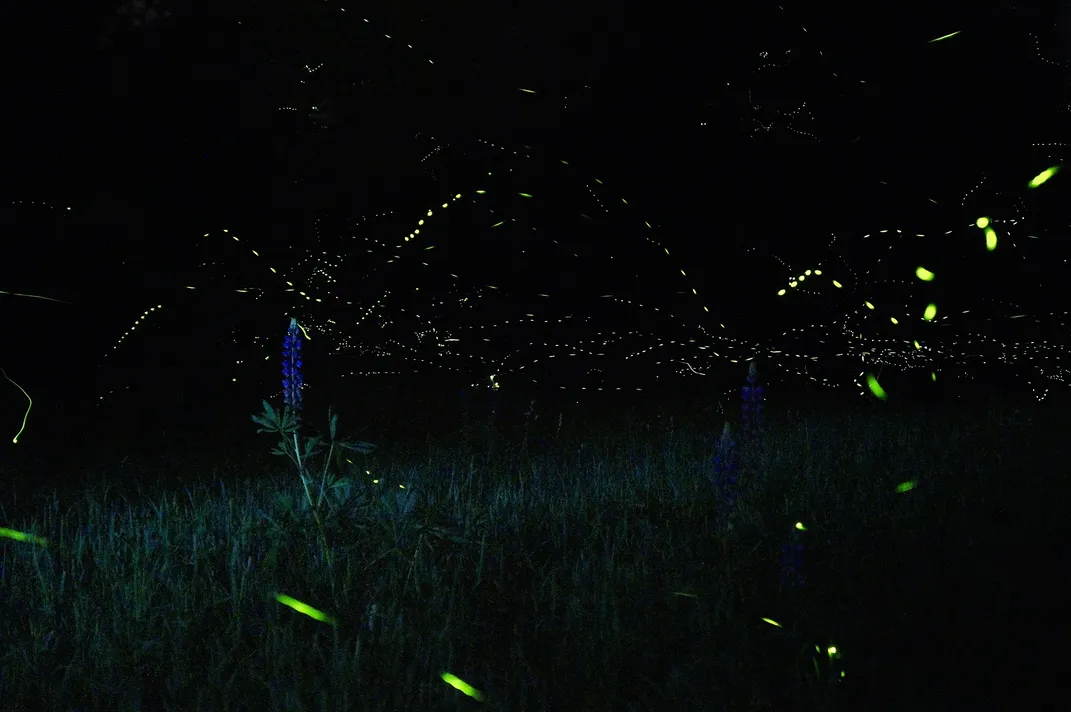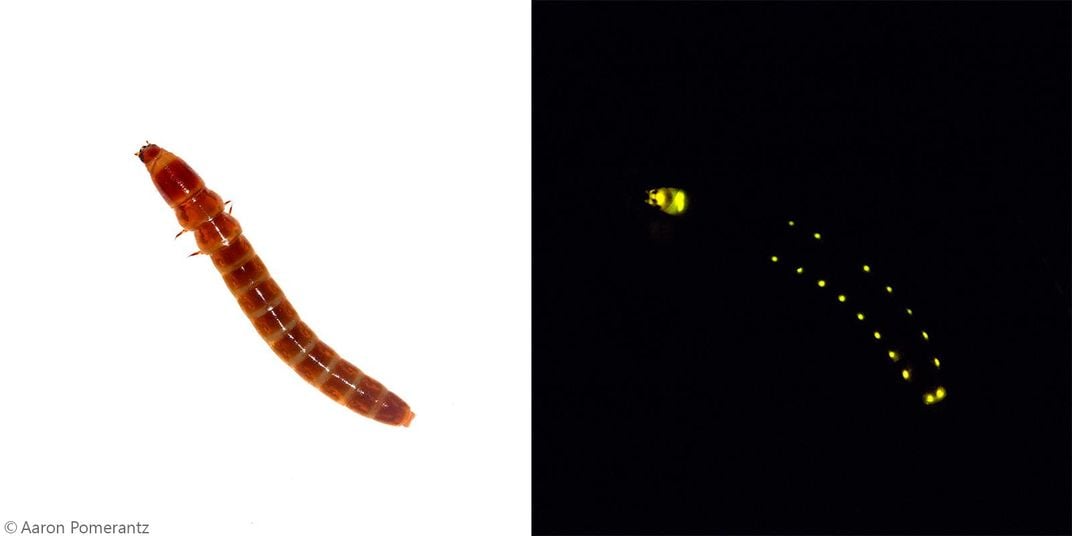Why Bioluminescence Evolved to Be Red Light, and Blue
The laws of nature constrict living light to a few hues, which also happen to be quite patriotic
/https://tf-cmsv2-smithsonianmag-media.s3.amazonaws.com/filer/89/62/8962e775-3531-43cf-a330-c41afaaf86df/squid2.jpg)
Fourth of July fireworks may be breathtaking, but Americans hardly have to wait until then for a spectacular light show: the world is constantly aglow, from the depths of the sea to the grass beneath your feet on sticky summer nights. Bioluminescence, the production of living light through glowing bacteria or chemical reactions, is one of nature’s most miraculous displays. And it’s surprisingly abundant, having evolved almost 30 times in marine fishes alone. But there’s something curious about these natural fireworks: they seem to have evolved into contained color categories that also happen to be quite patriotic.
Here’s why blues, reds and yellows tend to dominate light spectrum of the natural world.
Deep ocean blues

On moonless nights in some parts of the world, the surface of the sea shimmers with blue blooms of bioluminescent plankton. The prevalence of this phenomenon only increases with depth: over 50 percent of deep sea inhabitants glow. In fact, about 80 percent of our world’s bioluminescence lies beneath the ocean surface, with thousands of species of fish, bacteria, algae and worms illuminating the nooks and crannies of the deep. Yet despite this diversity, the bioluminescence of the sea is almost always emitted in one shade: blue. Why?
It turns out that, due to its intermediate wavelength, blue light travels the furthest in water. Visible lights with long wavelengths (such as red) and very short wavelengths (such as violet), are absorbed more quickly and filtered out. This phenomenon is, incidentally, also why the ocean appears blue. Shining in hues of aquamarine is thus the most efficient system for lighting the way. “There’s been a bit of a convergence on blue light [in marine environments],” says Matthew Davis, a marine biologist at St. Cloud University.
More than half of known bioluminescent fish species generate their own light through internal chemical reactions. The rest rely on teamwork between landlord fish and a teeming population of glowing tenant bacteria that inhabit a light organ on the fish’s body. In the latter cases, fish are born dull and must become stars: as they develop, they invite glowing microbes from the surrounding waters into their bodies, where the bacteria are provided with shelter and food in exchange for the labor of light.
This living light serves different purposes for different creatures. For some, it’s a powerful hunting weapon - a headlamp that lights the way for predatory fish. For others, it’s a beacon advertising receptiveness to potential mates.
The infamous anglerfish appears to use bioluminescence for both. Females bear striking blue orbs that dangle above their heads like neon fishing rods, bright enough to lure prey up to twice their size into their toothy maws. But these alluring lanterns also aid hapless males in making a match. And while female anglerfish are hard to miss, males are tragically dim in comparison—in more ways than one.
Male anglerfish are born with one goal: to find a mate. As such, they require no luminous accessories—only a keen sense of smell, to detect female pheromones, and sharp eyes, to glimpse a potential partner’s species-specific glow. Here, the blue light is of paramount importance: it is the species’ best interest for the female to shine as brightly as she can, and for the male to invest every resource possible into spotting it. As such, the male anglerfish barely has a digestive tract to speak of, and no instinct for the hunt.
But finding even a bright blue mate in a sea of darkness is a daunting task: up to 99 percent of males will die starving virgins. That may be the lesser of two evils. A successful male anglerfish has only moments to celebrate: the moment he touches his new bride, he gets attached—literally. His body quickly begins to disintegrate, fusing his flesh into hers until eventually they are one. In the end, little is left of the male save for his testes. A female will carry upwards of six males on her body at once as permanent saddlebags of sperm for later use at her discretion.
Blue light, it seems, is not always something you want to follow.
Lighting up the night

Above water, where light is abundant, bioluminescence doesn’t have the same competitive edge. It’s far less common to see creatures expending energy to make their own light when the environment provides it for them; that's why terrestrial bioluminescence is theorized to have evolved much later than marine. But several when land creatures do light up, they tend to glow yellow or green—and it's likely to take the place of the setting sun as dusk cloaks the landscape.
“Natural selection favors signals that are most easily seen—with the highest amount of contrast with the surrounding environment,” explains University of Florida entomologist Marc Branham.
Most notorious is the firefly (or lightning bug, depending on where you live), with over 2000 species that illuminate summer nights in flashes of yellow-gold-green. Firefly bioluminescence is believed to have originated as a warning to predators: I may look pretty, but I taste foul. But over time, these displays were repurposed for romance. The primary firefly love language is light, and courtship is an appropriately flashy process. Both males and females flicker, and every species of firefly has evolved a unique code to help potential mates cut through the noise.
Naturalist Lynn Faust, author of Fireflies, Glow-worms, and Lightning Bugs, works with “loopy 5” fireflies, so nicknamed partially for their striking aerial dances. “They combine flashes and glows and loops and swirls into ‘flash trains,’” says Faust. “It must be to please the ladies.” According to Faust, such complex displays don’t come cheap: males invest an enormous amount of work and energy in them despite their very short lifespans.
But some males may have developed a clever trick to double their output: reflecting their flashes on bodies of water that mirror their movements, making them look “super-male.” While Faust is not sure if this is entirely intentional, this species of firefly has evolved to live almost exclusively around ponds and marshes.
With fireflies, however, villains hide among the artists. Female Photuris versicolor fireflies, appropriately dubbed femme fatales, will mimic the luminous beckonings of other species—but when males approach expecting sex, they get devoured instead.
Sadly, most lightning bugs have bigger problems to worry about. Ever-increasing light pollution in urban centers around the world is obscuring natural bioluminescence, making it more difficult for glowing creatures to communicate and reproduce. Faust worries that we may see a decline in the pervasiveness of insect bioluminescence in years to come.
The red light district

Red light is relatively rare in both marine and terrestrial creatures, as these longer wavelengths can be too dim for even human eyes. But some animals have taken advantage of this fact. For instance, in the deep sea, many fish have lost the ability to see red. This turns out to work in favor of species low on the food chain: adorning your scales with shades of ruby means donning a cloak of invisibility.
Unless, that is, you’re being hunted by a stoplight loosejaw dragonfish. The stoplight loosejaw—named for its mousetrap-like maw, which unhinges to an unsightly degree so it can swallow prey whole—is the master of stealth. But its eerie grin isn't even the most unique feature of this deep sea ninja.
Like many of its neighbors, the stoplight loosejaw initially produces blue light, in this case from small glands beneath its eyes. But in a colorful twist, it is able to reabsorb this blue light into a protein that glows a subtle red. The reabsorption/re-emission process results in something akin to “a blacklight lighting up a Grateful Dead poster,” according to biologist Leo Smith, who studies the evolution of bioluminescence at the University of Kansas Biodiversity Institute in Lawrence.
What’s more, unlike most other deep-sea fish, the stoplight loosejaw is also one of few fish able to see long red wavelengths by producing a derivative of chlorophyll, the light-converting pigment typically found in plants. In a world where red light might as well be no light at all, this unusual ability allows the stoplight loosejaw to stalk its prey undetected.
Terrestrial creatures have picked up a similar gimmick. Railroad worms (which are actually not worms at all, but the larval form of a type of beetle) also use red spotlights mounted on their heads to sneak around the forest floor. Like land-based versions of dragonfish, they use this private wavelength to ambush myopic prey like tiny poachers in night-vision goggles.
So this July 5, when you're experiencing fireworks withdrawal, don't forget the living light shows going on all around you. And also, be grateful you aren't being stalked by a stoplight loosejaw.
/https://tf-cmsv2-smithsonianmag-media.s3.amazonaws.com/accounts/headshot/10172852_10152012979290896_320129237_n.jpg)
/https://tf-cmsv2-smithsonianmag-media.s3.amazonaws.com/accounts/headshot/10172852_10152012979290896_320129237_n.jpg)